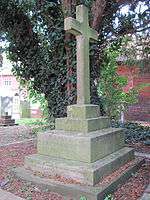Thomas William Brotherton
| Sir Thomas Brotherton | |
|---|---|
| Born | 1785 |
| Died | 20 January 1868 |
| Allegiance |
|
| Service/branch |
|
| Rank | General |
| Battles/wars |
Peninsular War French Revolutionary Wars |
| Awards | GCB |
General Sir Thomas William (Browne) Brotherton GCB (1785 – 20 January 1868), was a British Army officer.
Military career
Brotherton entered the 2nd or Coldstream Guards as an ensign in 1800, was promoted to lieutenant and to captain in 1801, and transferred to the 3rd or Scots Fusilier Guards in 1803.[1] With the guards he served under Ralph Abercromby in Egypt in 1801, and under Lord Cathcart in Hanover in 1805.[1] On 4 June 1807 he exchanged into the 14th Light Dragoons. With it he served almost continuously in the Peninsula from 1808 to 1814.[1] He was in Sir John Moore's retreat to Corunna; he was present at Talavera, at the actions on the Côa, at Bussaco, Fuentes de Oñoro, Battle of Salamanca, where he was wounded, Vitoria, the Pyrenees, the Nivelle, and the Nive, where he was severely wounded and taken prisoner.[1]

Wellington speaks of Brotherton's employment in the Estrella,[2] of his valuable reports,[3] of his conduct at the Côa,[4] and how he was exchanged after the battle of the Nive.[5] He was made major by brevet on Wellington's special recommendation on 28 Nov 1811, promoted major in his regiment on 26 May 1812, promoted to brevet lieutenant-colonel and appointed CB in 1817.[1]
In 1830 he was appointed aide-de-camp to the king and promoted to colonel, in 1841 he was promoted to major-general and in 1844 he became inspector-general of cavalry. In 1849 he was made colonel of the 15th hussars, in 1850 he was promoted to lieutenant-general and in 1855 he was advanced to KCB. In 1859 he became colonel of the 1st dragoon guards, in 1860 he was promoted to full general and in 1861 he was advanced to GCB.[1]
Marriages
Brotherton was married firstly in 1819 to Louisa Anne Straton (1802–1847), the daughter of General John Warde Straton.[6] By this marriage he had issue an only son, John William Brotherton, who died on 1 September 1878.[7]
In 1865, at the age of eighty, he was married to his second wife, Thomasina Hare, the daughter of the Rev. Walter Hare. Lady Brotherton died, aged 68 years, on 31 May 1895.[8]
Death
Brotherton died on 20 January 1868, at the age of eighty-three, at his son's house near Esher, now known as Upper Court. He is buried in the churchyard of St. Andrew's Church, Cobham.[9][10]
He left effects of more than £29 000.[11]
References
- 1 2 3 4 5 6 "Thomas William Brotherton". Oxford Dictionary of National Biography. Retrieved 18 June 2013.
- ↑ Wellington, Despatches, iv. p. 614
- ↑ Wellington, Despatches, v p. 79
- ↑ Wellington, Despatches, v. p. 293
- ↑ Wellington, Despatches, vii p. 237
- ↑ Death registered in Kensington registration district in the second quarter of 1847.
- ↑ The Times (Saturday, 7 September 1878), p. 1.
- ↑ Principal Probate Registry, Calendar of the Grants of Probate and Letters of Administration made in the Probate Registries of the High Court of Justice in England (1895), p. 295. Death registered in Fulham registration district in the second quarter of 1895 (age given as 84 years).
- ↑ "Thomas William Brotherton". Esher District Local History Society. Retrieved 8 November 2011.
- ↑ Death registered in Epsom registration district in the first quarter of 1868 (age given as 84 years).
- ↑ Principal Probate Registry, Calendar of the Grants of Probate and Letters of Administration made in the Probate Registries of the High Court of Justice in England (1868), pp. 138–139.
![]() This article incorporates text from a publication now in the public domain: "Brotherton, Thomas William". Dictionary of National Biography. London: Smith, Elder & Co. 1885–1900.
This article incorporates text from a publication now in the public domain: "Brotherton, Thomas William". Dictionary of National Biography. London: Smith, Elder & Co. 1885–1900.
| Military offices | ||
|---|---|---|
| Preceded by Sir Robert Thomas Wilson |
Colonel of the 15th (The King's) Regiment of (Light) Dragoons (Hussars) 1849–1859 |
Succeeded by Everard William Bouverie |
| Preceded by The Earl Cathcart |
Colonel of the 1st (King's) Dragoon Guards 1859–1868 |
Succeeded by Sir James Jackson |